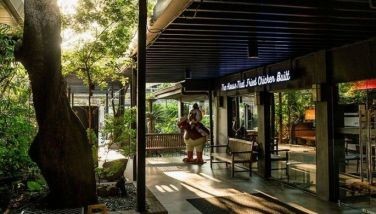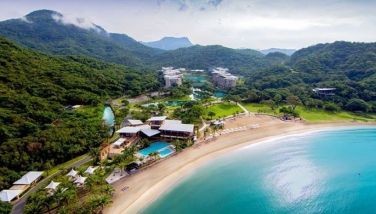100 Years of Motoring in the Philippines
June 23, 2004 | 12:00am
Despite the post-election protests and the uncertainties brought about by the rising fuel prices, depreciating peso and those pesky coup rumors and terrorists threats, the country celebrated its Independence Day yet again with the traditional parade in Luneta Park last Saturday, June 12. Highlighted by a passing review and a float parade of the different branches of government in front of the Quirino grandstand, the 106th anniversary of Philippine Independence was celebrated with the presence of the President and her official family and supporters, and a phalanx of PSG guards for security measures.
Car enthusiasts were also given a treat during the parade when the Department of Transportation and Communication (DOTC), in celebrating the 100 years of motoring in the country with the Land Transportation Office (LTO), featured historic icons of Philippine motoring in its parade contingent.
A small and curious-looking car and its proud owner paraded before the grandstand on top of a flat bed tow truck immediately after the DOTC float and the marching band. The flatbed was necessary because of the car’s age and significance to our country’s history. After all, the 1904 Richard-Brasier roadster was supposedly the very first automobile in the Philippines. Built by Georges Richard and Henri Brasier, it still has its original 9hp 2-cylinder engine. It was imported in 1904 into the country by the Jewish trading firm Estrella Del Norte and sold to the brothers Augusto and Demetrio Tuazon. The Tuazons later sold it to Senor Velasco, who eventually ended up selling it to a German national residing in the country before the war.
During the Japanese occupation, the car was thrown down a ravine so it won’t be of any use to the occupying forces. The history of the car became unknown after WWII until it ended up in the custody of Señor Antonio de la Vega, a certified car enthusiast who headed the Soriano Corporation in Bislig Bay in Mindanao and was one of the founders of Paper Industries Corporation of the Philippines (PICOP). He embarked on a restoration of the Richard-Brasier in 1960 and work progressed slowly until his death a couple of years ago curtailed the restoration. A French restorer and a Japanese collector submitted bids with de la Vega’s widow and planned to take the car out of the country. Ronald Reidenbach of the Vintage Car Club petitioned his club and the Manila Sports Car Club to acquire the car and salvage a piece of the country’s motoring history.
The Sytin family of the United Auctioneers fame funded the acquisition of the car but the real restoration work was done by noted TV host and current owner Cito Beltran. He said that he restored the 100 year-old vintage car as part of his contribution to the country’s history and its motoring heritage.
A 1928 Ford Model A Tudor sedan followed the 1904 Richard-Brasier. Driven under its own power by its proud owners, the husband-and-wife team of Romy and Julie Lupena, the 1928 Ford is the oldest running original car in the country. Its registration is current and the owner claims he drives the car every Sunday and that he has driven it to various car shows and had even gone to Baguio in it. Romy narrated how he likewise rescued the vehicle from the ravages of time and restored it to its current condition, refusing to succumb to modifications to make the car more modern and maintaining its original 4-cylinder engine, 6-volt electrical system and mechanically-actuated drum brakes.
While the old Ford and the Brasier represented the Vintage Car Club of the Philippines, a more modern 1970 Volkswagen Beetle represented the Volkswagen Club of the Philippines. Owner and restorer Romy de Ramos proudly drove his yellow Beetle in the parade with VW club president Doy Bondoc in the passenger seat. Romy’s VW is one of the finest examples of the popular "people’s car" among the club’s large roster of member’s cars. Like the old Ford, the Beetle was restored to its original state and sees regular driving duties around the streets of Metro Manila. While the VW Club has older and more historic cars in its roster, this 1970 Beetle is likewise significant since it represents the cut-off year that the LTO is proposing for its project to document and recognize the existing vintage cars in the country.
The last vehicle in the DOTC’s parade line-up was a yellow tow truck of the Automobile Association Philippines (AAP). Formerly called the Philippine Motor Association (PMA) when it was established in 1931, the AAP is the countryís first and oldest car club whose mission is to promote safe and enjoyable motoring around the Philippines. The 73-year-old national auto club currently represents its 60,000 members and private motorists in various activities with government agencies to advocate driving safety and the rights of the motorists, while it delivers a myriad of benefits and privileges to its members. As the Philippine affiliate of the Federation Internationale de l’ Automobile (FIA), the governing body of Formula One (F1) and the World Rally Championship (WRC) series, AAP issues racing licenses and inspects racing tracks as part of its contribution to the countryís motor sports. As a member of the Alliance de Internationale Tourisme (AIT), the club promotes tourism and its international reciprocity ensures that AAP members are assured of assistance from the automobile associations around the world. The AAP is likewise tasked by the LTO to issue international driving permits and authenticate undocumented vintage cars.
The DOTC parade was supposed to include a locally-assembled 1947 Studebaker and representatives from other car clubs but the heavy afternoon rains and the resulting traffic jam negated their participation, especially those collectors whose cars have finicky engines and convertible tops. While it had literally "rained on the parade", the Independence Day celebration offered a short respite from the country’s troubles and gave local car enthusiasts a glimpse of the first 100 years of local motoring.
Car enthusiasts were also given a treat during the parade when the Department of Transportation and Communication (DOTC), in celebrating the 100 years of motoring in the country with the Land Transportation Office (LTO), featured historic icons of Philippine motoring in its parade contingent.
A small and curious-looking car and its proud owner paraded before the grandstand on top of a flat bed tow truck immediately after the DOTC float and the marching band. The flatbed was necessary because of the car’s age and significance to our country’s history. After all, the 1904 Richard-Brasier roadster was supposedly the very first automobile in the Philippines. Built by Georges Richard and Henri Brasier, it still has its original 9hp 2-cylinder engine. It was imported in 1904 into the country by the Jewish trading firm Estrella Del Norte and sold to the brothers Augusto and Demetrio Tuazon. The Tuazons later sold it to Senor Velasco, who eventually ended up selling it to a German national residing in the country before the war.
During the Japanese occupation, the car was thrown down a ravine so it won’t be of any use to the occupying forces. The history of the car became unknown after WWII until it ended up in the custody of Señor Antonio de la Vega, a certified car enthusiast who headed the Soriano Corporation in Bislig Bay in Mindanao and was one of the founders of Paper Industries Corporation of the Philippines (PICOP). He embarked on a restoration of the Richard-Brasier in 1960 and work progressed slowly until his death a couple of years ago curtailed the restoration. A French restorer and a Japanese collector submitted bids with de la Vega’s widow and planned to take the car out of the country. Ronald Reidenbach of the Vintage Car Club petitioned his club and the Manila Sports Car Club to acquire the car and salvage a piece of the country’s motoring history.
The Sytin family of the United Auctioneers fame funded the acquisition of the car but the real restoration work was done by noted TV host and current owner Cito Beltran. He said that he restored the 100 year-old vintage car as part of his contribution to the country’s history and its motoring heritage.
A 1928 Ford Model A Tudor sedan followed the 1904 Richard-Brasier. Driven under its own power by its proud owners, the husband-and-wife team of Romy and Julie Lupena, the 1928 Ford is the oldest running original car in the country. Its registration is current and the owner claims he drives the car every Sunday and that he has driven it to various car shows and had even gone to Baguio in it. Romy narrated how he likewise rescued the vehicle from the ravages of time and restored it to its current condition, refusing to succumb to modifications to make the car more modern and maintaining its original 4-cylinder engine, 6-volt electrical system and mechanically-actuated drum brakes.
While the old Ford and the Brasier represented the Vintage Car Club of the Philippines, a more modern 1970 Volkswagen Beetle represented the Volkswagen Club of the Philippines. Owner and restorer Romy de Ramos proudly drove his yellow Beetle in the parade with VW club president Doy Bondoc in the passenger seat. Romy’s VW is one of the finest examples of the popular "people’s car" among the club’s large roster of member’s cars. Like the old Ford, the Beetle was restored to its original state and sees regular driving duties around the streets of Metro Manila. While the VW Club has older and more historic cars in its roster, this 1970 Beetle is likewise significant since it represents the cut-off year that the LTO is proposing for its project to document and recognize the existing vintage cars in the country.
The last vehicle in the DOTC’s parade line-up was a yellow tow truck of the Automobile Association Philippines (AAP). Formerly called the Philippine Motor Association (PMA) when it was established in 1931, the AAP is the countryís first and oldest car club whose mission is to promote safe and enjoyable motoring around the Philippines. The 73-year-old national auto club currently represents its 60,000 members and private motorists in various activities with government agencies to advocate driving safety and the rights of the motorists, while it delivers a myriad of benefits and privileges to its members. As the Philippine affiliate of the Federation Internationale de l’ Automobile (FIA), the governing body of Formula One (F1) and the World Rally Championship (WRC) series, AAP issues racing licenses and inspects racing tracks as part of its contribution to the countryís motor sports. As a member of the Alliance de Internationale Tourisme (AIT), the club promotes tourism and its international reciprocity ensures that AAP members are assured of assistance from the automobile associations around the world. The AAP is likewise tasked by the LTO to issue international driving permits and authenticate undocumented vintage cars.
The DOTC parade was supposed to include a locally-assembled 1947 Studebaker and representatives from other car clubs but the heavy afternoon rains and the resulting traffic jam negated their participation, especially those collectors whose cars have finicky engines and convertible tops. While it had literally "rained on the parade", the Independence Day celebration offered a short respite from the country’s troubles and gave local car enthusiasts a glimpse of the first 100 years of local motoring.
BrandSpace Articles
<
>
- Latest
Latest
Latest
December 3, 2024 - 4:00pm
December 3, 2024 - 4:00pm
October 4, 2024 - 6:00am
October 4, 2024 - 6:00am
September 30, 2024 - 4:26pm
By EC Toledo | September 30, 2024 - 4:26pm
September 26, 2024 - 3:30pm
September 26, 2024 - 3:30pm
Recommended


























